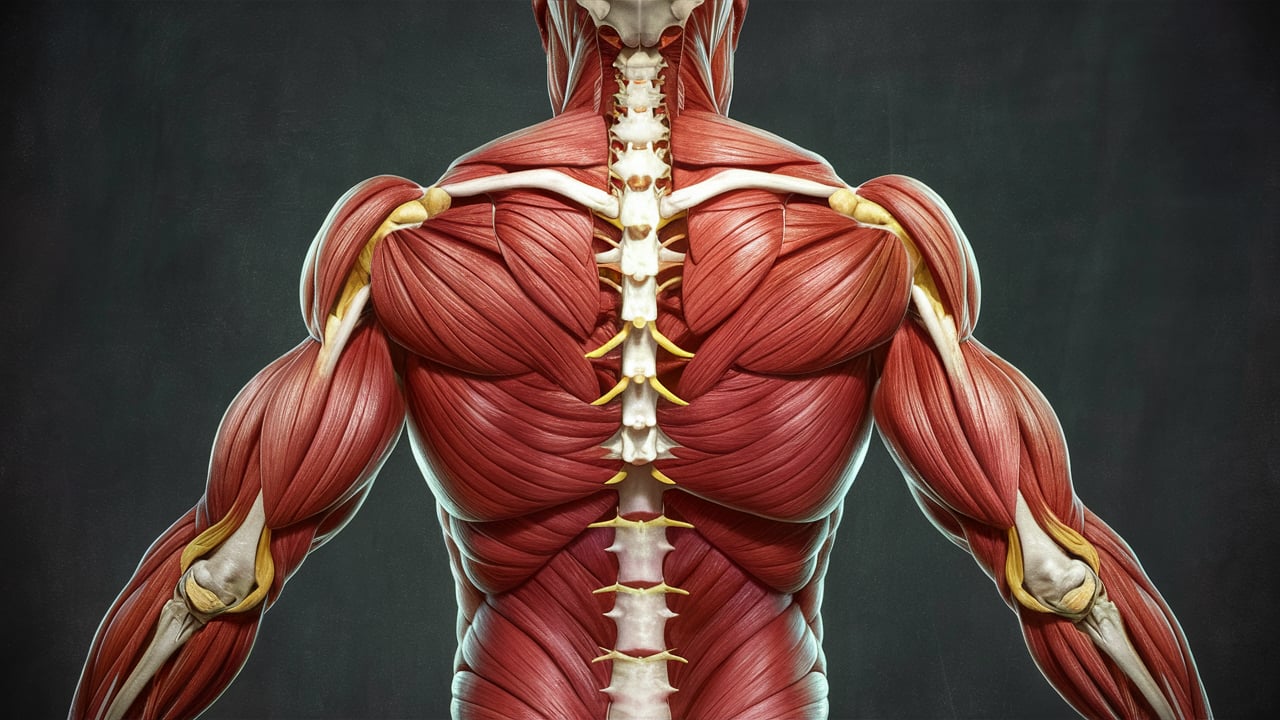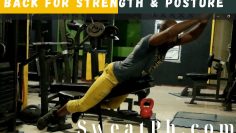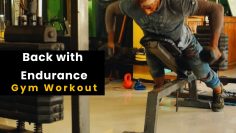The back muscles are among the largest and most powerful in the human body, playing a crucial role in movement, posture, and stability. These muscles work in concert to support the spine, facilitate movement, and protect vital organs. Understanding the anatomy and physiology of the back muscles is essential for anyone interested in health, fitness, or anatomy.
Anatomy of the Back Muscles
The back muscles are broadly categorized into three groups: the superficial, intermediate, and deep muscles. Each group serves specific functions, from controlling movements of the shoulders and arms to stabilizing the spine and facilitating respiration.
1. Superficial Back Muscles
The superficial back muscles are primarily responsible for the movements of the shoulder girdle, including the scapula and clavicle. These muscles connect the upper limbs to the trunk.
- Trapezius:
- The trapezius is a large, triangular muscle that extends from the base of the skull down to the lower thoracic vertebrae and across to the shoulder blade. It has three parts: the upper, middle, and lower trapezius, each responsible for different movements. The upper trapezius elevates the scapula (as in shrugging), the middle trapezius retracts the scapula (pulling the shoulder blades together), and the lower trapezius depresses the scapula. This muscle plays a critical role in maintaining posture and supporting the arm during various movements.
- Latissimus Dorsi:
- The latissimus dorsi, often referred to as the “lats,” is a broad, flat muscle that covers much of the lower back. It originates from the lower spine and pelvis and inserts into the humerus (upper arm bone). The lats are responsible for the extension, adduction, and internal rotation of the shoulder joint. They are heavily engaged during activities like pulling, lifting, and climbing.
- Rhomboids (Major and Minor):
- The rhomboid major and minor are located between the spine and the scapula. These muscles work to retract the scapula, bringing the shoulder blades together, and help maintain proper posture. The rhomboids also play a role in stabilizing the scapula during arm movements.
- Levator Scapulae:
- The levator scapulae is a small, strap-like muscle that runs along the side of the neck, connecting the cervical vertebrae to the scapula. Its primary function is to elevate the scapula, assisting in shoulder movements and contributing to neck posture.
2. Intermediate Back Muscles
The intermediate back muscles lie deeper than the superficial muscles and are primarily involved in respiratory functions.
- Serratus Posterior Superior:
- This thin muscle is located at the upper back, beneath the rhomboids. It assists in elevating the ribs during inspiration (breathing in), thereby playing a role in respiration.
- Serratus Posterior Inferior:
- Located in the lower back, this muscle helps to depress the ribs during forced expiration (breathing out). It works in opposition to the serratus posterior superior to regulate the movement of the ribs.
3. Deep Back Muscles
The deep back muscles, also known as the intrinsic back muscles, are primarily responsible for the stabilization and movement of the spine. These muscles are organized into three layers: the superficial, intermediate, and deep layers.
- Erector Spinae:
- The erector spinae is a group of muscles that runs along the length of the spine on either side. It consists of three muscle columns: the iliocostalis, longissimus, and spinalis. The erector spinae muscles are the main extensors of the spine, allowing you to straighten your back, stand upright, and perform movements like bending backward. These muscles also play a role in lateral flexion (side bending) and rotation of the spine.
- Transversospinales:
- The transversospinales muscles are a group of small, deep muscles that lie between the vertebrae. They include the semispinalis, multifidus, and rotatores muscles. These muscles are involved in the rotation, extension, and stabilization of the vertebral column. The multifidus, in particular, is essential for maintaining spinal stability and preventing back injuries.
- Quadratus Lumborum:
- The quadratus lumborum is a deep muscle located in the lower back, extending from the iliac crest (hip bone) to the lower ribs and lumbar vertebrae. It is responsible for lateral flexion of the spine (bending to the side) and also plays a role in stabilizing the pelvis during walking and other activities.
- Interspinales and Intertransversarii:
- These small muscles connect adjacent vertebrae and contribute to the fine movements of the spine, such as extension and lateral flexion. They also provide stability to the spinal column.
Physiology of the Back Muscles
The physiology of the back muscles is complex, involving coordination between various muscle groups, nervous system control, and interaction with other body systems. The primary functions of the back muscles include movement, posture, stabilization, and respiration.
1. Movement and Locomotion
The back muscles play a crucial role in facilitating a wide range of movements, including:
- Extension and Flexion: The erector spinae muscles are primarily responsible for extending the spine, allowing you to stand upright or bend backward. Conversely, the rectus abdominis and other abdominal muscles flex the spine, enabling you to bend forward.
- Lateral Flexion: The quadratus lumborum and erector spinae muscles on either side of the spine work together to allow side bending.
- Rotation: The transversospinales muscles, particularly the multifidus and rotatores, are involved in the rotation of the spine, enabling you to twist your torso.
These movements are essential for everyday activities, such as walking, lifting, bending, and twisting. The coordination between different muscle groups ensures smooth and efficient movement while maintaining balance and stability.
2. Posture and Stability
One of the primary functions of the back muscles is to maintain posture and provide stability to the spine. The deep back muscles, especially the erector spinae and multifidus, are constantly active, even when standing still, to keep the spine in a neutral position. This constant activity helps prevent the spine from collapsing under the weight of the upper body and contributes to maintaining an upright posture.
Proper posture is essential for minimizing the risk of injury and reducing the strain on the spine and surrounding structures. Poor posture, such as slouching or rounding the shoulders, can lead to imbalances in muscle tension, resulting in pain and discomfort. Over time, poor posture can contribute to conditions like kyphosis (excessive rounding of the upper back) or lordosis (excessive inward curvature of the lower back).
3. Spinal Protection
The deep back muscles, particularly the multifidus and other transversospinales muscles, play a vital role in protecting the spine by providing stability and controlling the movements of individual vertebrae. These muscles help prevent excessive movements that could damage the spinal joints, intervertebral discs, and other structures.
When lifting heavy objects or performing activities that place significant stress on the spine, the deep back muscles engage to stabilize the vertebrae and distribute the load evenly across the spine. This protective mechanism helps prevent injuries like herniated discs, strains, and sprains.
4. Respiration
While the primary muscles involved in respiration are the diaphragm and intercostal muscles, the back muscles, particularly the serratus posterior superior and inferior, assist in the process. During inhalation, the serratus posterior superior helps elevate the ribs, expanding the thoracic cavity and allowing the lungs to fill with air. During forced exhalation, the serratus posterior inferior helps depress the ribs, aiding in the expulsion of air from the lungs.
In addition to their role in respiration, the back muscles contribute to activities like coughing, sneezing, and laughing, where the rapid contraction of the muscles helps expel air from the lungs forcefully.
Common Issues and Injuries
Given the importance of the back muscles in supporting the body and facilitating movement, they are prone to various issues and injuries, including:
- Muscle Strains: Overstretching or tearing of the muscle fibers can result in muscle strains, which are common in the lower back. Strains often occur due to improper lifting techniques, sudden movements, or overuse during physical activity.
- Lower Back Pain: This is one of the most common musculoskeletal complaints and can be caused by muscle imbalances, poor posture, herniated discs, or other spinal issues. Chronic lower back pain can be debilitating and significantly impact daily life.
- Scoliosis: Scoliosis is a condition characterized by an abnormal lateral curvature of the spine. It can lead to imbalances in muscle tension and may require physical therapy or surgical intervention.
- Degenerative Disc Disease: This condition occurs when the intervertebral discs, which act as cushions between the vertebrae, begin to deteriorate with age. The resulting loss of disc height and flexibility can lead to pain, stiffness, and reduced mobility.
Conclusion
The back muscles are a vital component of the human musculoskeletal system, playing a key role in movement, posture, and stability. Understanding the anatomy and physiology of these muscles is essential for maintaining a healthy back, preventing injuries, and improving overall physical function. Regular exercise, proper posture, and attention to body mechanics are crucial for keeping the back muscles strong and resilient, enabling them to perform their essential functions throughout life.







